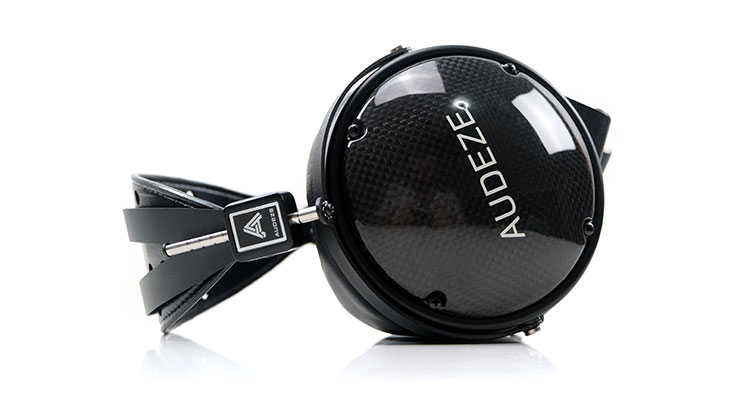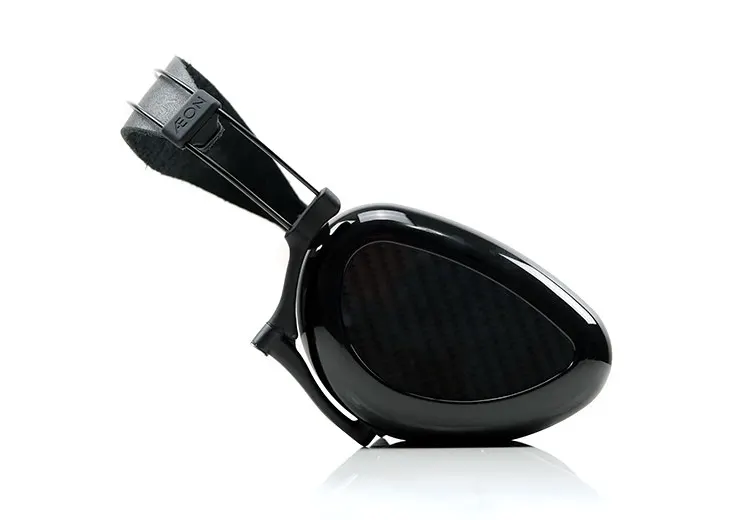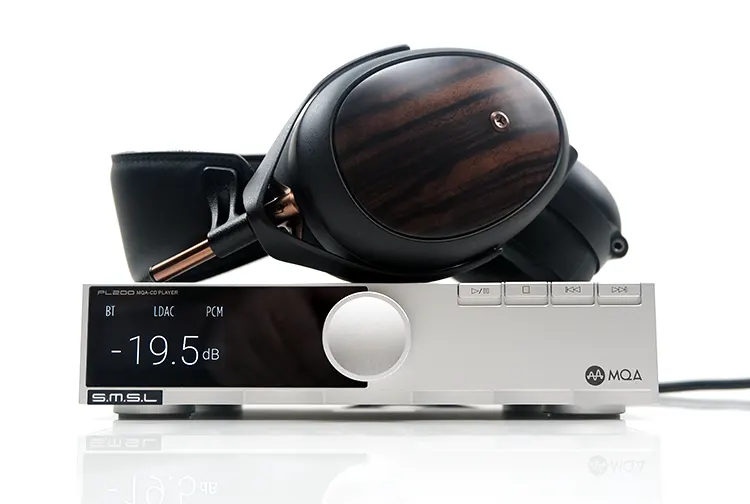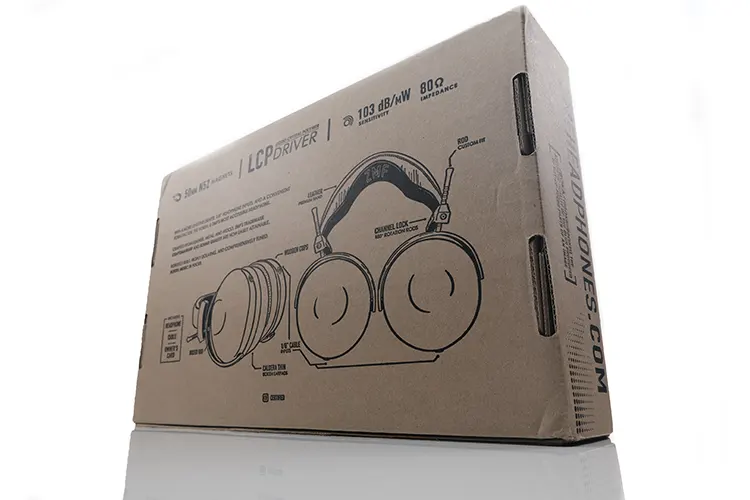Selected Comparisons
The following comparisons were completed using a mix of the ZMF Headphones Homage and the Ferrum OOR combined with the WANDLA/HYPSOS DAC and PSU and the Topping DX9 as a DAC.
All headphones were connected with their stock balanced cable and the BOKEH fitted with its default hybrid pads.
Audeze LCD-XC 2021
As the name suggests, the Audeze LCD-XC got a refresh in 2021 with our review coming out in August of that year. As of writing today, it is still Audeze’s flagship closed-back headphones and part of their wider Professional Series.
Technical
As with all 3 compared headphones, the LCD-XC is a closed-back headphone but one that uses a planar driver as opposed to BOKEH’s 50mm LCP dynamic driver.
It uses the older but still very performant 106mm dual-sized planar driver. Since its launch in 2014, Audeze has also continually reduced the thickness and resistance of the film on the LCD-XC driver diaphragm to keep it competitive.
Both headphones use Neodymium N50 magnets though this is much more extensive in the LCD-XC with a proprietary dual-sided stack array. The LCD-XC also includes the company’s Fazor technology though the ‘window’ count has been reduced to 6 from the original 8.
Further enhancements include Audeze lifting the LCD-XC pad ring slightly further from the main housing to enhance the ventilation performance of the LCD-XC 2021 pads and changing to a new type of memory foam inside the pads.
At 20Ω impedance and 101 dB/mW, the LCD-XC is technically easier to drive with a lower load requirement than the BOKEH’s 80Ω rating. Current is more your friend with the LCD-XC.
The BOKEH’s higher 103 dB/mW SPL rating might give it a small edge in sensitivity (volume and gain headroom). Neither are hard-to-drive headphones but the BOKEH does have room to scale with more voltage.
Design
Save for the elongated shaping of the BOKEH cups the general form factor of these headphones is quite similar.
They also share an odd component or two such as those notched adjuster rods though I find the new Katana sheath pivot block of the BOKEH the more attractive and low profile of the two headphone adjustment systems.
The aesthetics are hugely different though. The LCD-XC has a carbon fiber print behind a glossy Perspex protective cover screwed in on top with the big Audeze branding in the middle. It’s clean-looking but a world away from the wood cup finish of the original version.
This is ironic since the BOKEH cups are all about the wood and of the two I find them instantly more attractive to the eye, especially with the Claret stain on the Black Limba hardwood though I am sure the new natural version is just as cool.
I understand that the LCD-XC is being repositioned as part of their new pro series so wild color schemes might be deemed irrelevant.
Weight and pressure dissipation are important on both headphones. The BOKEH has a considerable advantage at around 480g compared to 677g, however, I find the lush thicker pads on the XC and slightly looser clamping to create a relatively relaxed and comfortable fitting.
The BOKEH is quite comfortable but there is a slightly enhanced lateral clamping feeling on my head so I feel that bit more with the hybrid pads. With the LCD-XC, the overall weight tends to make the vertical pressure on my scalp more noticeable after a while.
Performance
There are strikingly different presentations with the LCD-XC delivering a neutral to slightly bright mid-forward sound signature compared to a smoother, warmer, and more relaxed tuning from the BOKEH.
I will give credit where it is due, the LCD-XC planar driver has speed on its side and is a little more resolving, or at least subjectively with a stronger treble lifting up some subtle spatial cues’ presence and impact.
However, its north-of-neutral 1-3k range can pick up a lot of that upper-order harmonic overtone and will sound brighter with the Homage than the BOKEH pairing.
The LCD-XC responds well to PEQ. In my review back in 2021 I suggested lifting the otherwise flat and linear lows by a few dB with a shelf up to around 500hz to create volume and some additional warmth whilst dropping the 3-6k range by a few dB also.
That upper mids reduction reduces the spikiness of the stock tuning and introduces a stronger fundamental frequency making it a more ‘fun and welcoming’ performer, at least for audiophile purposes.
The BOKEH needs no EQ on the lows unless you are uncomfortable with a sliver of upper-bass bloom which I find slightly accentuated on the Homage.
It’s more elevated on the lows and more relaxed through the mids up to around 3-4k. It doesn’t have that intimate feeling of the LCD-XC nor does its timbre have too much treble overtone to create unwelcome sharpness.
I can see why the LCD-XC is pitched for the pro community these days. The control and resolution are excellent but it needs PEQ to move it from a pro audio tool to a headphone for casual or audiophile listening enjoyment.
The BOKEH is all about listening enjoyment out of the box but with slightly less focus on micro-detailing excellence.
Dan Clark Audio AEON 2 Noire
The very popular AEON 2 Noire is the final iteration of the mid-sized AEON series launched by Dan Clark Audio in 2021 and sells for $899.
Technical
Another closed-back planar headphone, this time with a smaller in-house design 62mm x 34mm single-sided V-planar magnetic driver so not massively bigger than the 50mm LCP dynamic driver inside the BOKEH.
The Noire has a new damping driver design with some claimed improvement in resolution over the AEON 2 closed-back version. The Atrium damping system inside the BOKEH from ZMF’s higher-end headphones is customized and tuned specifically for this headphone.
DCA’s TrueFLOW technology has trickled into the Noire with their older injection molding replaced by a machined FLOW structure that reduces the potential for air caps in the internal build.
The Noire has a very light load at 13Ω, much lower than the 80Ω rating of the BOKEH dynamic driver so voltage is not a priority for the DCA headphones. At 92dB/mW SPL, the Noire needs a lot more current headroom and is far less sensitive than the 101 dB/mW BOKEH.
Design
Aesthetics and comfort are understandably subjective and anecdotal but based on personal experience of both, the AEON 2 Noire is more comfortable and physically much more portable whereas the BOKEH is the visually more pleasing headphone.
I understand there was a demand for a black AEON 2 version but the previous red was more appealing to me. With the black, the contrast between the cups and carbon fiber plate is less emphasized and though streamlined it tends to just blend in the background rather than grab your eye.
The Bokeh is all about wow aesthetically with those claret-stained (or natural) Black Limba wood cups. They are attention seekers for sure.
Where the Noire hits a home run is in weight and comfort. I will also throw in passive isolation capability because it is excellent. The razor-thin Nitinol headband combined with a carbon fiber enclosure brings the overall weight down to 328g, over 150g less than the BOKEH.
That reduced weight and articulated folding frame make for a very portable set of planar headphones. This is ironic because it needs a good desktop amplifier to sound at its best whereas the BOKEH can feed off a dongle or a DAP.
The BOKEH does well in terms of isolation but it is slightly vented, more so than the Noire. Both have angled pad designs to follow the ear form factor but to get closer to the Noire passive isolation you have to swap the BOKEH hybrid pads out for the protein pads.
Performance
I kind of have a similar set of impressions for this comparison to the LCD-XC though obviously the Audeze and the Noire 2 do not share the same tuning.
Rather, the Noire runs neutral to bright as opposed to the Bokeh’s smooth and warm and can sound subjectively more resolving and controlled with less weight and a narrower soundstage.
Presentational-wise the Noire 2 does have more lower-mid presence up to 3k so vocals can take a more prominent position given its lows are flatter and more neutral in quantity.
The BOKEH is more relaxed over this same region with the upper-bass lift to 500Hz combined with a stronger upper-mids 3-5k tuning sometimes diminishing vocal presence when the lows get very busy.
However, the Noire has a thinner tonal quality courtesy of a stronger 5-8k lift. That means you get some hefty contrast on the instrumental timbre that isn’t balanced out by a high degree of bass warmth.
I sometimes find the Noire’s upper mids tonal bias to the upper harmonic order a bit distracting unless paired with a warmer source and amplifier. The white pads on the Noire will tame this nicely but at the cost of some veil through the mids.
That’s where the BOKEH with the hybrid pads has a distinct advantage. It sounds more euphonic through the mids with a reduced treble overtone and better bass warmth balancing it out.
I do like the clarity and depth of the Noire soundstage a lot. It has the planar speed and control advantage. The BOKEH is bigger and more atmospheric sounding at a macro level. It does sound weightier with a better fundamental frequency though imaging clarity is a shade behind the Noire.
Meze Audio Liric II
The 2024 Liric II is Meze Audio’s follow-up to the first Gen Liric original Liric launched in 2022. It is a little pricier than the BOKEH but is also pitched as being equally comfortable as a ‘portable’ headphone or a stay-at-home piece of gear.
Technical
The final planar headphone in this comparison and another second-generation driver. The Meze Audio Liric II retains the original’s MZ4 Isodynamic hybrid array driver, (active area of 3507mm²).
Much like the BOKEH’s 50mm LCP version, the switch in the driver is about performance in a portable package. The MZ4 is 50% lighter than Meze Audio’s MZ3 driver found in the Empyrean and is finished with reinforced polymer instead of fiberglass ABS for the housing.
The standout change in the Liric II is its QWRM technology. This is a quarter wavelength resonator mask applied with a specific focus on attenuating the FR above 7kHz, a response to the concerns of the Gen 1 Liric owners regarding the original’s spikey treble tuning.
The surprising element of the Liric II driver design is the efficiency at 60Ω. You do not normally see a higher impedance driver in portable planar headphones lately. The BOKEH is higher at 80Ω but less current demanding and more sensitive at 103 dB/mw compared to 101 dB/mW for the Liric II.
Design
This is a similar comparison in some respects as the Noire versus BOKEH analysis. The Liric is a slick-looking set of headphones, beautifully engineered, and with an edge in short to medium-term listening comfort.
I must add however, that I do not consider the Liric II to be a true circumaural headphone, more like an oversized supraaural because a lot of the pad does press down on my outer ear rather than clear it in the same manner as the BOKEH pads.
That might mean for some that after a very long listening session, you could get ear fatigue depending on how the Liric II pads sit on your ear.
It has not quite happened to me yet but there is a noticeable amount of pressure there compared to the Bokeh whose lateral clamping produces a slightly stronger effect around the ear.
The Liric II feels subjectively looser for its clamping and though its PES airflow system has a slither of venting it’s not quite as well vented as the BOKEH cups. Combined with the enhanced venting and the wider hybrid pads the BOKEH slips behind the Liric II a bit for passive isolation capability.
The LIRIC II incorporates wood into its design but it’s more of an afterthought with some wood facades on the magnesium cups that I find are more decorative than central to the theme. I would consider the chassis the Liric II’s major design triumph.
The BOKEH wood cups are central to their headphones’ performance and theme and are the standout aesthetic of the headphones. This is a more confident application of wood from ZMF and as such the visual is more appealing.
Performance
I find the Bokeh tonal performance more agreeable but I recognize the overall clarity and control from the Liric II driver. There will be fans of both sound signatures.
Overall, the Liric II has a more neutral quality to its coloration but I do not find it bass-light so to speak, rather the emphasis is further down sub-80Hz and quite flat and neutral from around 150Hz up to the mids at 1k.
That keeps a high level of bass-to-mids separation with a less fulsome tonal quality through the lower-mids. The BOKEH goes somewhat in the opposite direction with the hybrid pads, less so with the Protein pads which sound closer to the extended sub-bass shelf of the Liric II.
With the hybrid pads, the BOKEH is more balanced with an uplift in the mid-to-upper bass rather than sub-bass dominance giving it a bigger sound perhaps but not quite as planted as the Liric II.
It will subjectively sound bigger and warmer through to the lower mids creating a generally stronger perception of bass in most recordings.
The Liric II has done away with the peaky overtones of the Liric Gen 1 but overall it’s a slightly leaner note quality with a bit more of a treble influence through the mids and high timbre.
It is still quite refined for me, and if you are after clarity and precise or complex imaging then its planar driver is very good at delivering the micro-detail and speed required at that level.
The BOKEH is less proficient in this area but makes up for it with a bigger soundstage at a macro level, noticeably so compared to the Liric II. I would define it as less nuanced but more bombastic and tonally agreeable in its delivery.
My Verdict
The ZMF Headphones BOKEH is a spacious ‘fun sounding’ set of dynamic driver headphones with plenty of that ‘ZMF flavor’ thrown in to create a highly tweakable but always very enjoyable tonal quality to its performance.
It is not the most detailed or accurate set of high-end headphones, but if it’s a daily carry I am not 100% sure that matters as much. From my experience you want your music to resonate and quite often a little exaggeration does that quite well.
What it also does well in is the looks department but then again, it’s a ZMF Headphone, which should come as no surprise. The Black Limba is now natural wood rather than my Claret Red but it still looks striking, sits comfortably, and provides a decent level of isolation.
These are ZMF’s most accessible headphones I have reviewed to date. Not just in terms of price but in also what it plays well from. Both portable and desktop fans should try it, it’s a pleasing intro into the world of ZMF Headphones.
ZMF Headphones Bokeh Technical Specifications
- Impedance: 80 Ohms
- Driver: LCP (Liquid Crystal Polymer)
- Weight: 480g ±30g
- Sensitivity: ~103dB/mW






